1. 引言
近年来,我国近岸海域赤潮发生的频率、波及范围和危害程度呈上升趋势[1] 。赤潮的发生对海洋生态环境、渔业资源和海水养殖业直接或间接的造成了不可估量的负面影响,成为当前污染生态学研究的热点之一。而且,近海富营养化和有害赤潮,由于其全球性、多发性、复杂性和危害严重等特点,早已成为国际社会共同关注的、新出现的重大海洋环境问题,也是亟需解决的海洋生态灾害之一。
由于赤潮生消过程及其与物理、化学和生态学过程相互作用的复杂性,特别是对赤潮生物孢囊萌发和上浮、种群增殖和生物竞争、摄食等过程的了解尚少,因此到目前为止有关赤潮全过程及成因的定量评价资料十分贫乏,以致绝大多数赤潮原因种的种群动力学机制及其发生赤潮机理尚未被阐明[2] 。
臭氧层的侵蚀是当今全球性的重大环境问题之一,由于臭氧层侵蚀和破坏的日趋加重,使得到达地面的紫外线,尤其是对生物有较大伤害作用的紫外线B波段——UV-B(280~320 nm)的辐射增强。UV-B的增强已影响整个地面生态系统的变化,特别是海洋生物(尤其是海洋浮游生物)受紫外线辐射影响和伤害的潜在危险性不断增加,海洋浮游植物是海洋的主要初级生产者,是海洋食物链的基础,浮游植物的变化将导致整个海洋生态系统的结构和功能发生改变[3] 。
本文选择了我国沿海地区常见的赤潮藻种米氏凯伦藻(Karenia mikimotoi Hansen)和赤潮异弯藻(Heterosigma akashiwo Hada)两种海洋微藻为研究对象,在UV-B辐射的影响下,研究两种赤潮藻之间的种群竞争关系,以期为阐明UV-B辐射对赤潮发生机制及对海洋生态系统的影响提供基础的实验依据。
2. 材料与方法
2.1. 实验藻种
实验所用的藻种米氏凯伦藻(K. mikimotoi)和赤潮异弯藻(H. akashiwo)均取自中国海洋大学生命科学学院微藻研究中心。
2.2. 实验方法
单培养实验:取指数生长期的微藻藻液,分别按照1 × 104 cell∙ml−1和4 × 104 cell∙ml−1的起始密度,分别接种在120 mLf/2 [4] 培养液中。每个处理设3个平行样,两种藻的处理相同。
共培养实验:1) 米氏凯伦藻(简称K)的起始密度为4 × 104 cell∙ml−1,赤潮异弯藻(简称H)的起始密度为1 × 104 cell∙ml−1,接种比例为K:H = 4:1;2) 米氏凯伦藻和赤潮异弯藻的起始密度均为1 × 104 cell∙ml−1,接种比例为K:H = 1:1;3) 米氏凯伦藻的起始密度为1 × 104 cell∙ml−1,赤潮异弯藻的起始密度为4 × 104 cell∙ml−1,接种比例为K:H = 1:4。每个处理组设3个平行样。
2.3. 培养方法和条件
单培养和共培养实验均在光照培养箱中进行。培养温度为(20 ± 1)℃,光照强度为3000 lx,光暗周期12L:12D,培养液采用f/2营养盐配方。所用海水取自青岛的天然海水,经脱脂棉过滤,煮沸消毒。培养过程中每天摇动培养瓶3次。
2.4. UV-B辐射处理
采用北京曙光电源厂生产的紫外B灯处理实验材料。紫外B灯外用乙酸纤维素薄膜包被,以除去小于280 nm的短波照射,整个装置在实验前需连续照射72 h,以减少薄膜滤过作用的不稳定性。所有薄膜每隔一周更换一次,为了防止薄膜的老化作用[5] 。辐射强度一定(1.25 μW∙cm−2),通过控制辐射时间来调节辐射剂量。在预备实验的前提下,设计1.4 J∙m−2的辐射剂量来照射藻液。
2.5. 细胞密度和参数的计算
细胞密度的测定用Lugol碘液固定样品,血球计数板计数。每个样品计数5次,取其平均值。
取细胞密度达到最大值之前的数据,以Logistic方程的积分式: 做模型公式,用Excel做辅助,进行非线性回归分析,获得K(最大环境容量)、a(曲线对原点的相对位置)和r(种群增长率)的估计值。Tp为Logistic方程二阶导数等于零时的时间值,这时
做模型公式,用Excel做辅助,进行非线性回归分析,获得K(最大环境容量)、a(曲线对原点的相对位置)和r(种群增长率)的估计值。Tp为Logistic方程二阶导数等于零时的时间值,这时 ,
, 。因为是差分形式,所以Tp对
。因为是差分形式,所以Tp对 取整数[6] 。
取整数[6] 。
3. 结果与讨论
3.1. 单培养体系中米氏凯伦藻和赤潮异弯藻的生长情况及分析
在不同起始浓度浓度下,米氏凯伦藻(K)生长曲线见图1,赤潮异弯藻(H)生长曲线见图2。从两图中可以看出,不同起始浓度下的米氏凯伦藻和赤潮异弯藻的生长曲线均呈现出典型的Logistic“S”型增长模式。Logistic种群增长模型对结果进行拟合后所得的参数见表1和表2,可以发现随着起始密度的增加这两种藻的瞬时增长率r和环境负载能力K均减少,到达拐点的时间(Tp)均缩短。
单培养体系中不同起始密度下米氏凯伦藻和赤潮异弯藻的生长具有相似性。由两者的逻辑斯蒂方程
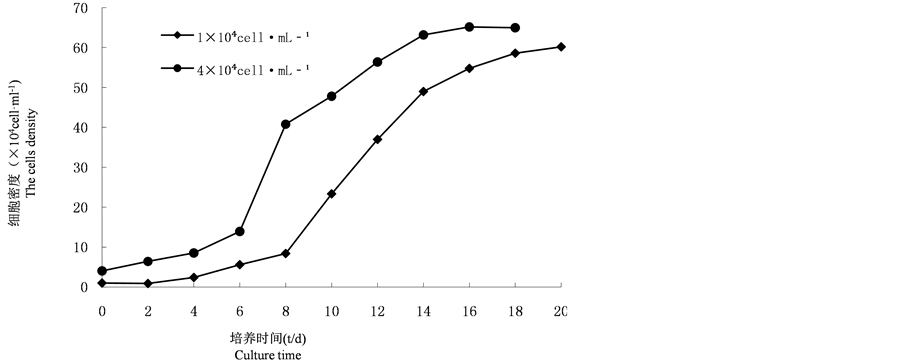
Figure 1. The grow curves of K. mikimotoi at different initial cell densities
图1. 不同起始密度下米氏凯伦藻的生长曲线
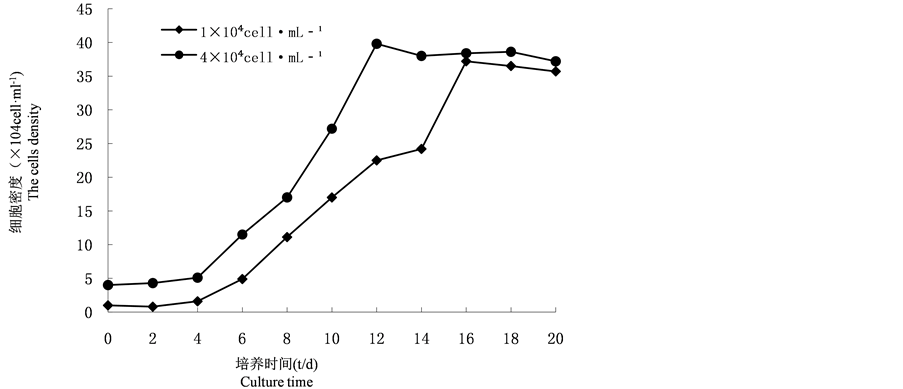
Figure 2. The grow curves of H. akshiwo at different initial cell densities
图2. 不同起始密度下赤潮异弯藻的生长曲线

Table 1. The growth parameters of K. mikimotoi population at different initial cell densities
表1. 不同起始密度下米氏凯伦藻种群的生长参数的比较

Table 2. The growth parameters of H. akshiwo population at different initial cell densities
表2. 不同起始密度下赤潮异弯藻种群的生长参数的比较
可得,环境承载力(K)、瞬时增长率(r)和进入拐点的时间(Tp)随着种群密度的增大而减小,进入稳定期的时间保持不变,但米氏凯伦藻进入生长期的时间随着种群密度的增大而减小,而赤潮异弯藻的生长期没有明显变化。赤潮异弯藻在两种不同起始密度条件下种群进入指数生长期和静止期的时间均比赤潮异弯藻的短,即在同样的条件下,赤潮异弯藻生长的较快,很快进入指数生长期和静止期,达到最大种群密度。故在实际中,更容易在较短的时间内形成赤潮。
不同起始密度对赤潮藻的生长产生很大的影响,一方面是由于藻种自身的生长和繁殖的特性所决定;另一方面,种群密度作为种群最基本的特征,受到其他许多理化环境因素的影响,如光照、pH和溶解氧等。同时,不同密度的种群对外部环境资源的利用速率有所不同[7] ,这也可能是影响其生长状况的一个因素。
3.2. 共培养体系中米氏凯伦藻和赤潮异弯藻的生长变化
3.2.1. 无UV-B辐射时米氏凯伦藻和赤潮异弯藻的生长情况及分析
由图3所示,当米氏凯伦藻与赤潮异弯藻的起始密度比为1:1时,米氏凯伦藻的回归曲线为N = 85.25662/(1 + e5.0168−0.274t) (R2 = 0.934),K为85.25662 × 104 cell∙mL−1,r为0.274,Tp为18.30949 d,进入指数生长期和静止期时间分别为4.0和22.0 d;赤潮异弯藻的回归曲线为N = 45.20234/(1 + e4.8924−0.3303t) (R2 = 0.8963),K为45.20234 × 104 cell∙mL−1,r为0.3303,Tp为14.8 d,进入指数生长期和静止期的时间分别为4.0和20.0 d。与单培养时相比,米氏凯伦藻的K值减小,而赤潮异弯藻的K值增大;两者的r值都减小。米氏凯伦藻比赤潮异弯藻呈现出明显的Logistic“S”型增长。因此,米氏凯伦藻占优势。
当米氏凯伦藻与赤潮异弯藻的起始密度比为4:1,米氏凯伦藻的回归曲线为N = 53.42819/(1 + e3.5081−0.3681t) (R2 = 0.7565),K为53.42819 × 104 cell∙mL−1,r为0.3681,Tp为9.530291 d,进入指数生长期和静止期的时间分别为2.0和16.0 d;赤潮异弯藻的回归曲线为N = 33.8/(1 + e4.5028−0.3657t) (R2 = 0.9493),K为33.8 × 104 cell∙mL−1,r为0.3657,Tp为12.31282 d,进入指数生长期和静止期的时间分别为2.0和14.0 d。两者都呈现出明显的Logistic“S”型增长。在共培养体系中,米氏凯伦藻和赤潮异弯藻均可迅速进入指数增长期,但二者之间存在一定的差异,由于米氏凯伦藻的环境负载能力K和瞬时增长率r大于赤潮异弯藻的环境负载能力K和瞬时增长率r,且米氏凯伦藻的种群数量增长较赤潮异弯藻的迅速,因此米氏凯伦藻在种间竞争中占有优势。
当米氏凯伦藻与赤潮异弯藻的起始密度比为1:4时,米氏凯伦藻的生长曲线近似于直线增长,其种
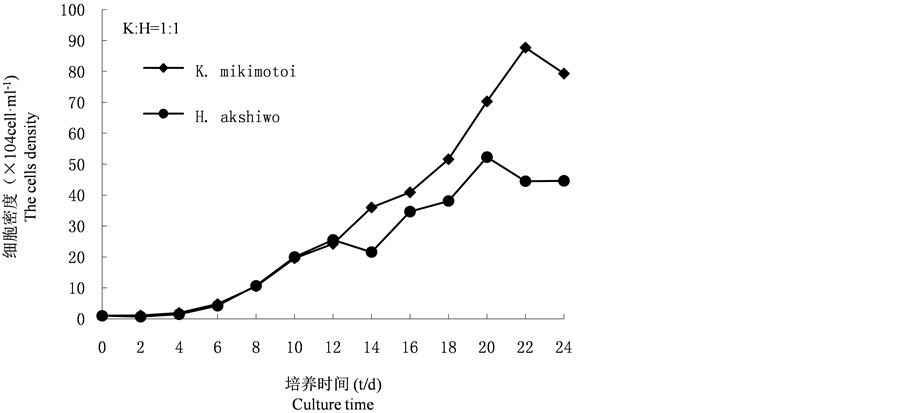
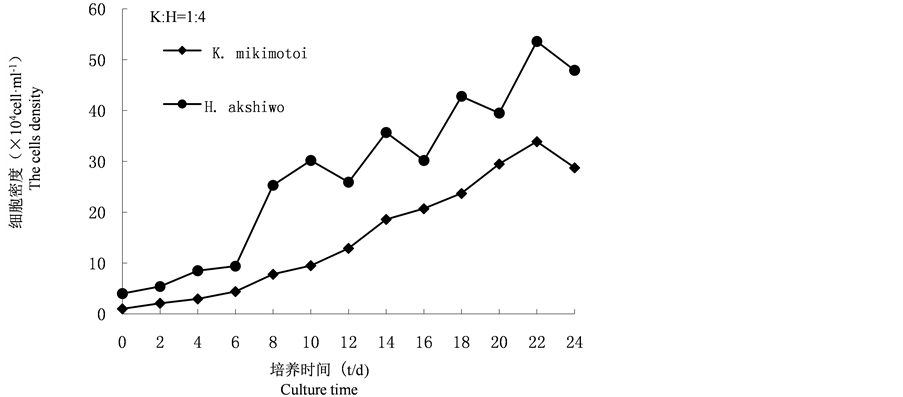
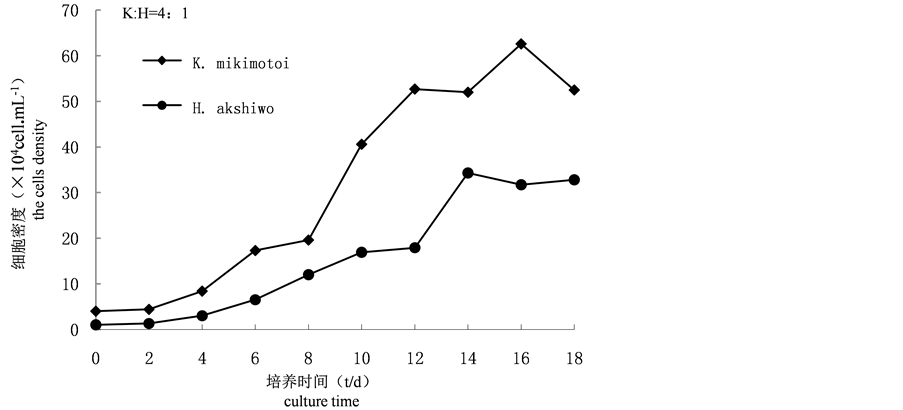
Figure 3. Effects of different inoculative proportions on the competition between K. mikimotoi and H. akshiwo populations
图3. 不同起始密度对米氏凯伦藻和赤潮异弯藻种群竞争的影响
群最大密度33.9 × 104 cell∙mL−1为单培养时种群最大密度70.8 × 104 cell∙mL−1的47.9%;赤潮异弯藻的种群最大密度为53.6 × 104 cell∙mL−1,为单培养时种群最大密度39.0 × 104 cell∙mL−1的137.4%,虽然赤潮异弯藻能进入指数增长期,却是在上下振荡中保持增长,没有呈现出明显的Logistic“S”型增长,但在竞争中依然占优势。
在共培养体系中,接种比例的不同会直接导致米氏凯伦藻和赤潮异弯藻之间种群竞争关系的变化:当接种比例为K:H = 1:4时,赤潮异弯藻在竞争中占明显的优势;当接种比例为K:H = 1:1时,米氏凯伦藻在竞争中占有一定的优势;当接种比例为K:H = 4:1时,米氏凯伦藻的竞争优势更加明显。
对于赤潮发生过程中种群间的竞争作用有两种不同的观点。一种观点认为,赤潮发生过程中营养盐的大量消耗引起种群竞争关系的改变,优势种随之发生更迭[8] -[10] ;而另一种观点认为,引起种群竞争关系发生改变的主要原因是赤潮微藻的克生作用[11] -[14] 。本实验是在特定的实验条件下进行,具有充足的光照,营养盐和适宜的温度,可排除营养水平上的竞争机制,故其种间关系的改变主要是由于微藻的克生作用。有研究发现克生作用效果与微藻的密度有关[15] ,微藻密度较低时,分泌的克生物质浓度也低,生物可能对其产生适应性;微藻密度越大,在适合的条件分泌的克生物质越多,如果暴露在其中的生物越少,则每个生物相应分得的毒物越多,毒性作用总体效果就越强.生物群落的平衡受到与其有关的各种物理、化学及生物因素的影响。种群之间的相互作用对群落的平衡有一定的调节作用。通过藻类胞外活性物质的相互影响,可以直接实现藻类与其它生物类群之间、藻类不同种群之间的相互作用,从而影响藻类群落的组成、演替和平衡[16] [17] 。Fogg和Hellbust首次研究发现,海洋藻类在生长过程中会不断向周围环境中释放多种代谢产物,如碳水化合物、氨基酸、酶、脂类、维生素、有机磷酸、毒素、挥发性物质以及抑制和促进因子等[18] 。
3.2.2. 有UV-B辐射时米氏凯伦藻和赤潮异弯藻的生长情况及分析
由图4所知,当米氏凯伦藻与赤潮异弯藻的起始密度为1:1时,米氏凯伦藻和赤潮异弯藻呈现出明显的Logistic“S”型增长。米氏凯伦藻的回归曲线为N = 16.50788/(1 + e3.0675−0.31t) (R2 = 0.6591),K为16.50788 × 104 cell∙mL−1,r为0.31,Tp为9.895 d,进入指数生长期和静止期的时间分别为1.0和16.0 d;赤潮异弯藻的回归曲线为N = 44.60362/(1 + e3.2822−0.3492t) (R2 = 0.602),K为44.60362 × 104 cell∙mL−1,r为0.3492,Tp为9.399198 d,进入指数生长期和静止期的时间分别为2.0和16.0 d。与无UV-B辐射时相比,米氏凯伦藻的K值明显减小,仅为无辐射时的19.4%,而赤潮异弯藻的K值几乎无变化,并且赤潮异弯藻的r值增大。因此,赤潮异弯藻成为优势种。
当米氏凯伦藻与赤潮异弯藻的起始密度比为4:1时,米氏凯伦藻和赤潮异弯藻没有呈现出明显的Logistic“S”型增长。米氏凯伦藻在第4 d进入对数期,在第18 d进入稳定期并达到最大细胞密度38.2 × 104 cell∙mL−1,是无辐射时最大细胞密度的61.0%;赤潮异弯藻在第4 d进入对数期,在第18 d进入稳定期并达到最大细胞密度25.5 × 104 cell∙mL−1,是无辐射时最大细胞密度的74.3%。由于米氏凯伦藻的K值大于赤潮异弯藻的K值,且米氏凯伦藻的起始密度大。所以,当有UV-B的影响时,两者的最大密度都减小,但米氏凯伦藻占有优势。
当米氏凯伦藻与赤潮异弯藻的起始密度为1:4时,米氏凯伦藻和赤潮异弯藻没有呈现出明显的Logistic“S”型增长。赤潮异弯藻在第2 d进入生长期,在第12 d达到最大种群密度32.8 × 104 cell∙mL−1,是无辐射时最大种群密度的61.2%,然后密度突降,第14 d至第20 d,种群密度几乎无变化;在第20 d时,密度又下降。米氏凯伦藻却在一个较低密度水平(<10 × 104 cell∙mL−1)左右保持平稳变化。由图4可知,赤潮异弯藻在种群竞争中占明显的优势。
有研究表明,UV-B辐射增强对海洋微藻有一定的伤害作用[19] [20] 。并且不同种类的海洋微藻对

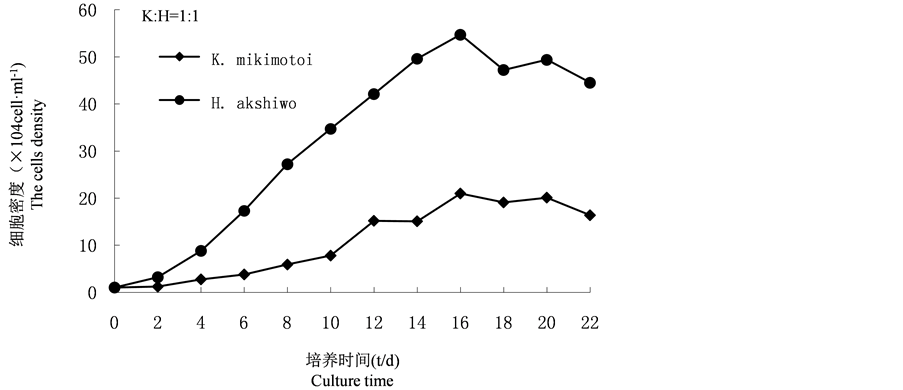

Figure 4. Effects of UV-B radiation enhancement on the competition between K. mikimotoi and H. akshiwo populations
图4. UV-B辐射增强对米氏凯伦藻和赤潮异弯藻种群竞争的影响
UV-B辐射处理的敏感性有较大的差异,敏感性高的种类易受到UV-B辐射处理的伤害,引起生长的减缓;而敏感性低的种类不易甚至不会受到UV-B辐射处理的伤害,其生长速率相对提高[5] [21] 。因此,UV-B辐射处理打破了种群间原有的生长平衡状态,使种群间的竞争关系发生改变。本实验选用的米氏凯伦藻和赤潮异弯藻在UV-B辐射的作用下,只有当K:H为1:1时,较无辐射时种群竞争的优势种发生改变。这说明在种群密度相同的作用下,米氏凯伦藻对UV-B辐射的敏感性比赤潮异弯藻的敏感性强。
4. 结论
本次实验通过对米氏凯伦藻和赤潮异弯藻的单培养及有无UV-B辐射的共培养,得到以下结论:
1) 在单培养体系中,米氏凯伦藻和赤潮异弯藻的接种密度不同直接导致了其各自生长情况有所差异。
2) 在共培养体系中,米氏凯伦藻在处理K:H = 1:1和处理K:H = 4:1中占有优势,且最大种群密度较单养时有所下降;赤潮异弯藻在处理K:H = 1:4中占有优势。因此,营养盐与种群间的克生作用极有可能是影响种群间竞争的作用机制,这需要进一步的研究。
3) 在UV-B辐射处理体系中,与无UV-B辐射对照组进行比较,UV-B辐射可改变米氏凯伦藻和赤潮异弯藻种群竞争的关系,使赤潮异弯藻种群竞争能力增强,米氏凯伦藻种群竞争能力降低,从而导致赤潮异弯藻在处理K:H = 1:1中占优势,在处理K:H = 1:4中的优势地位更加明显。

NOTES
*通讯作者。